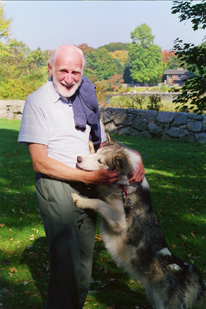Table of Contents
*
Featured Inuit Dog Owner: Ove Nygaard
*
An Amazing Lead Dog: The Story of Tatra
*
A Mystic Reunion
*
Katan, the Greenland Pup
*
Oregon Dune Musher's Mail Run
*
High Arctic Mushing: Part II
*
Bibliography: Inuit Sled Dog Research
*
Video Review: Atanarjuat, The Fast Runner
*
Book Review: To a Lonely Land I Know
*
IMHO: Visibility
Navigating This
Site
Index of articles by subject
Index
of back issues by volume number
Search The
Fan Hitch
Articles
to download and print
Ordering
Ken MacRury's Thesis
Our
comprehensive list of resources
Talk
to The Fan
Hitch
The Fan Hitch
home page
ISDI
home page
Editor: Sue Hamilton
Webmaster: Mark Hamilton
Contents of The Fan Hitch Website and its publications are protected by international copyright laws. No photo, drawing or text may be reproduced in any form without written consent. Webmasters please note: written consent is necessary before linking this site to yours! Please forward requests to Sue Hamilton, 55 Town Line Rd., Harwinton, Connecticut 06791, USA or mail@thefanhitch.org

Antarctic veteran Ken Blaiklock and Aqsaq at the
Nathanial Palmer House in Stonington, Connecticut
Bellars photo
A Mystic Reunion, October, 2001
by Andrew and Penny Bellars, Dorset, England
Just imagine, a first trip to America to fulfill a lifelong dream! The excuse, an Anglo-American Antarctic reunion at Stonington, Connecticut, which is unusual enough. However, thanks to the internet, and an almost casual introduction to ISDI, the whole thing was transformed. We had noted that Mark and Sue Hamilton lived in the same state as the meeting place, and tentatively asked them if we could call in for coffee? "No", said Sue, "We don't do just coffee, so come and stay!"
No one who has worked in the Antarctic could be indifferent to sled dogs, and no one could therefore resist this wonderful invitation. We were determined that the awfulness of September 11, 2001 would not stop the world, and so we four, Phil and Brigid Wainwright, and Andrew and Penny Bellars, made the journey from Norway and England, respectively, to Harwinton, Connecticut.
We wended our way through the changing colours (note correct spelling!) of a spectacular Fall. Excellent instructions led us to the Hamilton's "salt-box" house. We knew we had arrived, when, alerted by the sound of our rented car, we saw a number of pricked ears, and reflections of bright, curious eyes. And that was just the dogs!
What a greeting we received! We humans must have known each other in a previous life, for there was an immediate and unshakable bond between us all. Conversation flowed, with anecdotes and information tumbling out, punctuated by peals of laughter. We shall never forget the magic of that evening, sitting outside on the decking, by the warmth of the pot-bellied stove. The leaves were gently floating off the trees as dusk fell, and we found ourselves with lapsful of dog, as they took turns for exercise and hugs.
We shall particularly treasure being reintroduced to that phenomenon of the canine "Angelus", or sing-song. We call it "Angelus" because it seems to happen daily at 7 a.m., 12 noon, and 7 p.m.. One dog starts singing, and gradually the others chime in, for a beautiful harmonic chorus. The question remains, how do they know how to stop together, as if at some signal the final coda is arrested? Really moving, yet reassuring, and totally extraordinary.
Inevitably, after two unforgettable days, the time came to leave for the Reunion. By now, plans had been made for Mark and Sue to join us at the official Reception at the Palmer House, Stonington, Conn. The island on the Antarctic Peninsula was named Stonington after the New England seaport, since Nathaniel Palmer discovered the Peninsula; hence, it is sometimes called Palmer Land.
The Hamiltons arrived with their special dog-carrying vehicle, and eight dogs, which were spanned out in the shady grounds. We think that they planned to stay two to three hours, but that was all changed by the welcome, and sustained interest. They became the centre of attraction. In the days when we had dogs in the Antarctic, they were friends and confidantes to many, not just the drivers, and we saw special moments of quiet memories rekindled.
By taking such trouble, and sharing the dogs with us all, the Hamiltons provided one of the many highlights of a very extraordinary journey. We shall never regret having the cheek to make ourselves known to them, and through them and Geneviève to you all. We think ISDI is a great organisation.
Perhaps our greatest regret was hearing from the Antarctic veterans, and the Hamiltons, that they could confirm what a dreadful sadness it was to have done away with the British Antarctic Sledge Dogs. They were a special population, bred with loving care for that Peninsula work, and were unique in that respect. We should have kept a small number as a genetic pool, and for educational and morale-boosting purposes.
They are greatly missed.
Andrew
and Penny Bellars
Holbrooks